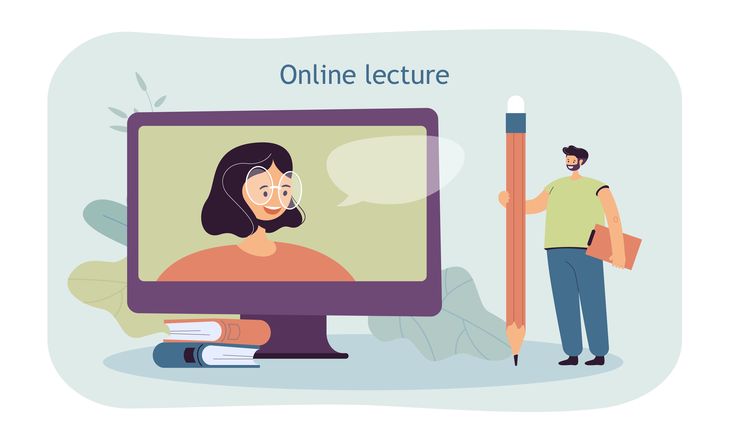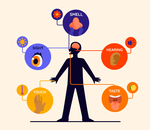How to Identify and Manage Stress in Distance Learning
Oct 25, 2025 by Vreny Blanco · 14 min read · Mental Health, Remote Work

Pursuing a distance learning program is a bold and forward-thinking decision: you’re investing in your future, building new skills, and gathering experiences that will accompany you throughout your life. But alongside all the opportunities, distance learning also brings its own unique challenges. Balancing family, work, and studies, setting your priorities, and organizing your time efficiently can be a real challenge—and this often becomes a source of stress.
In this article, you’ll learn:
- What is stress?
- How does stress develop?
- Why isn’t stress always negative?
- What are the most common stress factors in distance learning—and how can you handle them?
The goal of this article is to provide you with tools to help you recognize your main sources of stress and find suitable coping strategies. In this way, you’ll gain more control over your emotions and your learning process—allowing you to shape your distance studies with a greater sense of well-being and motivation.
Subscribe to the 1Focus Blog and stay on track: 1Focus Blog RSS Feed.
🤯 What Is Stress, Really?
Everyone talks about stress, but what does it really mean?
In scientific literature, stress is defined as a nonspecific response of the body to any demand (Selye, 1956, as cited in Scherenberg & Buchwald, 2015), which causes a disruption of both physical and mental balance.
Before stress shows itself through obvious symptoms—like absenteeism or learning difficulties—it usually appears as feelings of internal tension, restlessness, or fear (Scherenberg & Buchwald, 2015).
Stress is a natural reaction of your body to challenges, and by itself, it’s not necessarily a bad thing. The important thing is to recognize the warning signs in time and learn how to manage them.
When was the last time you noticed that you were stressed? What were the first physical signs you noticed?
⚡️ Triggers and Reactions
Stress can be broken down into two components: the stress situation (also called the stressor or external trigger) and the stress reaction (the actual response to the trigger).
-
The Stress Situation (Stressor, External Trigger): This is the external stimulus or demand placed on you. In distance learning, this could include things like time pressure, an upcoming exam, a deadline for a paper, conflicts with family members at home, or a lack of free time.
-
The Stress Reaction (Response): This is how your body and mind respond to a stressful situation. Typical reactions include a racing heart, sweating, internal restlessness, or feelings of anxiety.
Example: Think about how you feel the day before an important exam, or on the morning of the test: Maybe you notice your heart beating faster, you feel tense, or you have trouble sleeping well.
🤔 Personal Perception of Stressful Situations
Whether you experience a situation as stressful or not largely depends on your individual perception and assessment.
Stress arises when you feel that the demands placed on you exceed your resources or your ability to cope.
This internal evaluation process can be understood in three steps:
- Situation: A demand arises (for example, the deadline for a final paper).
- Assessment: Internally, you ask yourself: “Can I do this? Do I have enough time, knowledge, and energy to handle this task?”
- Result: Your answer to this question determines whether you experience stress or well-being. If your answer is “No” or “I’m not sure,” stress emerges. However, if you think, “Yes, I can handle this!” you feel capable of managing the situation.
Individual Differences in Stress Reactions
Everyone reacts to stress differently, and these responses can show up physically, emotionally, and mentally.
What may be an exciting challenge for one person can trigger anxiety and uncertainty in someone else. For example, a part-time distance learning program might be seen as a positive and motivating change by some (new career opportunities, personal growth), while for others it stirs up worries and fears (fear of failure, fear of losing life balance).
Effects of Stress on Well-Being and Health
The stress you experience in distance learning, at work, or in your relationships can affect your well-being and health both in the short and long term:
- Fatigue, irritability, or a bad mood are immediate consequences.
- But if stress lasts for a long time, it can lead to frustration, job dissatisfaction, or even mental and physical health issues, as well as chronic conditions.
Stress can show up in your behavior, your feelings, your mood, and even physically in your body.
🧩 Three Ways to Interpret a Situation
How you interpret a situation can place it into three different categories—and each one triggers different emotions:
Loss
Loss of resources can refer to valuable assets, both material and emotional: health, happiness, time, skills, competencies, or even social support. Everything you use to manage your life counts as a resource.
Stressful situations—whether major life events or small daily challenges—directly affect your resources. Under pressure, you rely on whatever resources are available to you.
Stress arises when you lose many resources or fear losing them. Imagine tackling a task with lots of motivation, but already sensing that you might fail: This creates stress because you perceive that your motivation, optimism, or hopes are threatened.
In other words, stress is your personal perception and evaluation of an actual or potential loss of resources—or the absence of an adequate gain after investing resources. When stress persists over a longer period, this process can lead to a loss spiral that becomes harder to break as more of your resources are depleted (Hobfoll & Buchwald, 2004, as cited in Scherenberg & Buchwald, 2015).
Threat
In this case, you’re afraid that something negative might happen in the future (for example, not passing an exam). This often leads to feelings of anxiety and worry.
Challenge
Here, you perceive the situation as a chance to grow or to achieve something (for example, conquering a tough assignment). This sparks positive emotions like confidence, joy, and curiosity.
Depending on how you interpret a situation, stress can be both a negative force and a positive, motivating energy. This distinction is crucial for your well-being in distance learning.
How you perceive a situation is always subjective and depends on various factors—such as your current mood, past experiences, and personality traits.
⚠️ Personal Traits That Can Intensify Stress
Certain personal characteristics can make you experience more stress in everyday life. These include (Kaluza, 2014, as cited in Scherenberg & Buchwald, 2015):
- Impatience
- Perfectionism
- Seeking validation or approval
- A strong need for control
- Tendency to want to solve everything on your own
- Excessively high self-demands
- Strong desire for harmony, even at the expense of your own well-being
- Difficulty saying “no” when needed
📍 Common Challenges and Stressors in Distance Learning
Distance learning comes with unique challenges that can quickly become sources of stress. Knowing about these factors is essential so you can recognize them early, prevent them, and cope more effectively.
Social Isolation
Compared to traditional in-person programs, you have much less direct interaction with fellow students in distance learning. This sense of isolation can be demotivating, since mutual support and informal conversation are often missing.
To counter this, you can intentionally seek out study groups, actively participate in group projects, and stay connected with others through student forums. Today, it’s easier than ever to build new communities and make connections remotely. You can also attend your school’s networking events or get involved in student initiatives to expand your support network.
New Learning Format
Many people who start a distance learning program already have a completed vocational qualification or several years of work experience. Often, distance learning serves as an additional credential or specialization alongside your current job.
Getting used to a regular study routine and new formats of assessment can create uncertainty—especially if your last degree or training was a while ago, or if current learning methods are very different from what you’ve experienced before.
To make the transition to this new learning format easier, it’s a good idea to get familiar early with your study plan, course structure, applications, and the technical requirements on your computer. This way, you’ll always be ready to access your online campus.
Most online universities offer introductory sessions for new students right before the semester begins. In these sessions, you can learn to use the online campus, explore your program, ask questions, check your access to the library and digital resources, and get support from faculty and fellow students.
To help you master this new challenge, here are some helpful resources with techniques and strategies to optimize your learning:
- How to Learn Effectively with the PQ4R Method
- Flow: What Is It, How Do You Achieve It, and Why Does It Improve Your Concentration?
- 7 Mnemonics to Train Your Memory
- How Emotions Affect Your Memory and Concentration
Time Management
One of the biggest challenges in distance learning is often effective time management. In this study format, there are usually no set class times—you can access learning materials anytime within a given period and move forward at your own pace: watching lessons, reading materials, and completing assignments whenever it works best for you.
On one hand, this flexibility is a major advantage. On the other, it can be a significant challenge, since it requires you to set priorities and organize your own schedule. If you also have to coordinate family and work responsibilities, this can quickly add up to a serious mental load.
Here are some proven time management techniques to help you succeed in distance learning:
- The Pareto Principle (80/20 Rule): Focus on the 20% of activities that generate 80% of your results.
- Time Blocking: Schedule dedicated periods in your calendar for studying, breaks, and other commitments.
- The Eisenhower Matrix: Sort your tasks by urgency and importance to decide what you should focus on first.
- Eat That Frog: Start your day with the hardest or most important task to maximize energy and avoid procrastination.
- Parkinson’s Law: Remember that work expands to fill the time available—so set clear time limits for each activity.
Doubts About Your Own Abilities
Especially at the beginning of a distance learning program, you might find yourself asking: “Am I up to this challenge?” “Did I choose the right field?” or “Can I really do this?” These kinds of doubts can become a major source of stress and—if left unaddressed—can affect your motivation and self-confidence.
Remember: you’re not alone. Many people feel uncertain when starting something new or challenging. The key is to notice these thoughts, avoid self-blame, and actively look for strategies to address them.
Here are some helpful resources for overcoming fears and doubts:
- How to Strengthen Your Mental Health: Step-by-Step Guide
- Expert Tip: Strategies for Better Mental Health
- Motivation Tips for Students
If you need support, seek professional help or talk to people you trust about your concerns. Connecting with your study group can also be helpful—chances are, your fellow students have similar experiences. Mutual support within your team can boost your confidence and provide a sense of security.
Comparing Yourself to Others
Especially in distance learning, it’s easy to compare yourself to others: Who has already submitted the next assignment? Who’s especially active in the forum? Who seems to handle everything with ease? These comparisons are completely natural—but they can quickly become a source of stress.
If you measure yourself against other students and feel less successful, less organized, or less motivated, it can impact your self-esteem and motivation. Studies show that comparing yourself to seemingly “perfect” classmates or peers often leads to frustration, self-doubt, and additional pressure (Scherenberg & Buchwald, 2015).
What’s often overlooked is that everyone starts from a different place, with unique strengths, interests, and personal circumstances.
Instead of measuring yourself against others, ask yourself:
- What are my own goals in this distance learning program?
- What truly motivates me?
- What small progress have I made lately?
Comparisons can also be inspiring—for example, you might learn new study strategies from others or feel encouraged to be more relaxed. The key is to establish your own standards and not let outside ideals pressure you.
Don’t compare yourself to others—compare yourself to your past self, and celebrate every step of your personal progress!
Self-Organization
Without the structure of an on-campus university, you’re in charge of motivating yourself, organizing your study times, and staying disciplined every day. This level of self-management can be a real challenge—especially when distractions or other commitments come up.
That’s why it’s especially important to create clear schedules, build a consistent study routine, and set up a workspace dedicated just to reading and studying.
If you’d like to dive deeper into this topic, check out:
Lack of Support
Sometimes people around you don’t understand or appreciate how much effort distance learning really requires. If your workload isn’t recognized at work, in your family, or by friends, this can lead to conflict and an increase in emotional stress.
In these situations, it’s important to communicate your needs clearly and explain why your study time matters. Look for allies in your environment, share your successes and challenges with loved ones, and don’t hesitate to reach out to student communities or support groups where you can find understanding and encouragement.
Too Few or Too Many Demands
Not every subject will feel equally easy for you. Maybe one module is boring because it’s too simple, while another might be overwhelming and lead to frustration and stress.
Remember: it’s completely normal to feel this way, and everyone has different strengths and areas for growth. If a project feels too easy, find extra challenges or personal projects that motivate you and help you keep growing. If you find a subject especially difficult, don’t hesitate to ask for help, use additional resources, or connect with your study group.
Sharing your questions and experiences can make a big difference and help you get through difficult times.
Test Anxiety
Nervousness before exams is very common. It can range from mild tension to mental blocks that make studying difficult and affect your entire preparation process. Recognizing this anxiety is the first step to managing it.
Practice relaxation techniques, create a realistic study plan, and remind yourself that mistakes are part of the learning process. Talk to others about your concerns—this can help relieve pressure and remind you that you’re not alone.
Here are some helpful resources to better manage stress and emotions:
- How to Calm Anxiety with the 5-4-3-2-1 Technique
- What Are the 4 A’s of Stress Management and How Do You Use Them?
- How Emotions Affect Your Memory and Concentration
💻 Online Distractions and Distance Learning
Distance learning offers many benefits, but it also brings the challenge of studying in an environment filled with digital distractions: emails, Netflix, Reddit, Disney+, YouTube, WhatsApp, social media, notifications, and videos can disrupt your concentration at any moment.
Research shows that even a single notification can interrupt your focus—and simply having your smartphone within reach can negatively impact your performance. In addition, digital multitasking—constantly switching between chats, emails, and social platforms—leads to lower quality learning and increased stress.
What can you do to protect your concentration?
- Identify your main distractions: Make a list of the apps and websites that consume most of your time.
- Schedule focused study sessions: Use strategies like time blocking, and consider using tools like 1Focus to block WhatsApp, social media, and other distractions on your Mac during study sessions. Turn off notifications on your smartphone and keep it out of sight and out of reach during study time.
- Avoid multitasking: Focus on one task at a time to boost your productivity and reduce mental fatigue.
Remember: The key is to recognize distractions early and create routines that help you stay focused. If you want to explore this topic further, check out these articles:
🚀 Takeaways
- Stress is normal—and it can be helpful: Feeling stressed is a natural response of your body and mind to challenges. What matters is how you manage it and whether you recognize the warning signs early.
- Your perception matters: A situation becomes stressful only if you feel the demands exceed your resources. How you interpret and evaluate each challenge is key to your well-being.
- Know the most common stress factors in distance learning: Social isolation, time pressure, self-organization, self-doubt, and lack of support are frequent sources of stress. These can affect your physical, emotional, and mental health.
- Stress can be negative or positive: It all depends on whether you view the situation as a loss, threat, or challenge. Stress can be overwhelming, but it can also motivate you and help you grow.
- Your personality and resources matter: Traits like perfectionism, impatience, or high self-demands can raise your stress levels. Learning to manage your personal resources helps you avoid the “loss spiral.”
- Self-management is your best ally: Establish set times for studying, resting, and relaxing. Set priorities and adjust your expectations to match your current reality.
- Reflect and connect: Observe your stress patterns, talk about your experiences, and make use of the support resources available to you.
📚 Keep Reading
The content of this article is based on the book “Stressmanagement im Fernstudium” by Scherenberg, V., & Buchwald, P., and has been adapted by the author drawing on personal experience and opinions. This article is not sponsored, and no compensation was received for its creation.



